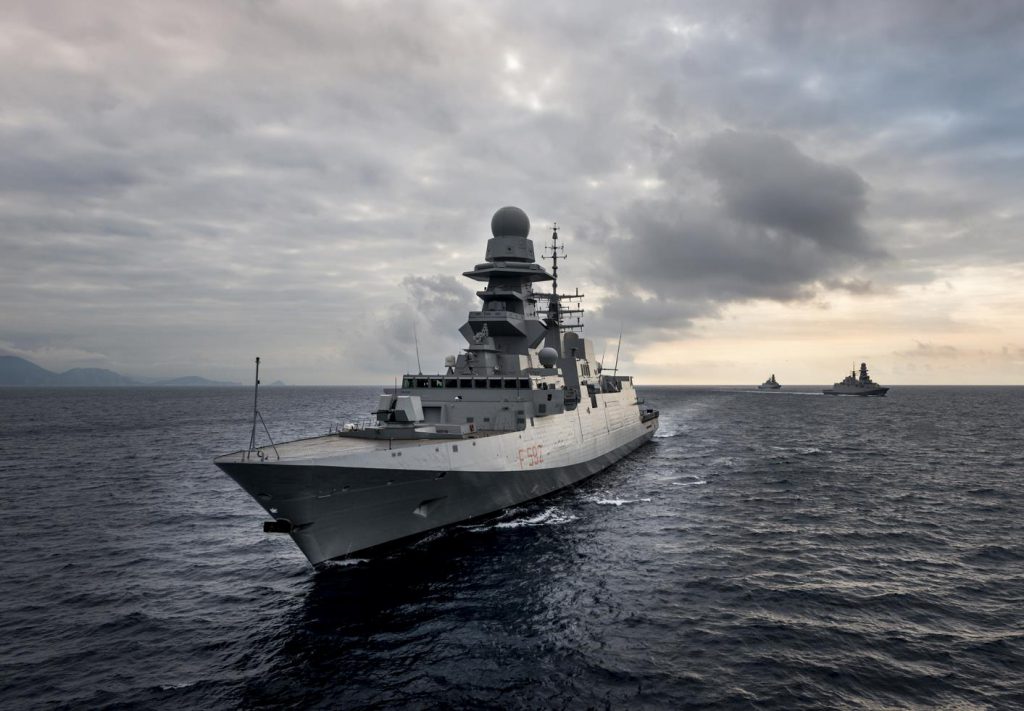
Italian FREMM, the basis for the FFG-62 program. Fincantieri Marine Group Image
The lead ship in the Navy’s next-generation frigate class could cost $1.6 billion, a figure that is 40 percent above the service’s projections for the first-in-class vessel, according to the Congressional Budget Office.
A new report from CBO approximates the cost for the first 10 ships in the FFG-62 program, formerly FFG(X), at $12.3 billion.
“Using three other surface combatants—the Arleigh Burke Flight III, the LCS-3 (the second ship of the Freedom-class LCS), and the DD-963 Spruance—as analogies, CBO estimates the cost of procuring the lead FFG(X) to be $1.6 billion, or 40 percent more than the Navy’s estimate. CBO estimates the average cost of the first 10 ships of the program would be about $1.2 billion per ship, or a total of $12.3 billion, which is also about 40 percent more than the Navy’s estimate,” the report reads.
“Those 10 ships would cost $205 million for every thousand tons of lightship displacement. The Navy has not estimated the cost of the second 10 ships of the frigate program; CBO estimates those ships would cost an average of $1.1 billion per ship, or another $10.9 billion, assuming the Navy uses the same design and the ships are built by Marinette Marine,” it continues.
According to CBO, the Navy’s projections have each ship costing $870 million for a total price tag of $8.7 billion “in 2020 dollars” for the first 10 ships.
“In the Navy’s 2021 budget, which was submitted to the Congress before the winner of the FFG(X) competition was announced, the service estimated that the first FFG(X) would cost $1.2 billion in 2020 dollars (or $1.3 billion in nominal, or current, dollars),” the report reads. “The average cost of the second through tenth ships, the Navy estimated, would be $835 million per ship. The total cost for the first 10 ships would be $8.7 billion (or $9.8 billion in nominal dollars).”
The report comes several months after the Navy issued a $795-million award to Fincantieri Marinette Marine to construct the lead ship, with options for a total of 10 ships. The service is expected to purchase 20 frigates, but Navy acquisition chief James Geurts told reporters earlier this year that the service has not yet decided on its acquisition approach for the next 10 vessels.
CBO noted there are multiple elements to bolster the Navy’s projections for FFG(X), but also various reasons indicating the service’s forecasts could be lower than reality. The report cites a reported Pentagon Cost Assessment and Program Evaluation forecast that is slightly below the Navy’s projection for the program, the fact that the new frigate is based off a proven design (the FREMM multi-mission frigate the Italian and French navies sail), and that the service employs most of the technology that it plans to put on the frigate on in-service ships.

Fincantieri FFG(X) Design based on the FREMM. Fincantieri Image
But the report cites several historical examples — including that the service has previously underestimated lead ship price tags — in noting why the Navy’s estimates could be inaccurate.
“[E]xperience with the Arleigh Burke destroyer suggests cost growth is likely. Although the Navy has argued that major parts of the FFG(X)’s estimated cost are known quantities because it is familiar with so much of the ship’s combat systems, weapons, and power systems, reducing the risk of cost growth, the same was also true for the Arleigh Burke when it was designed and built,” the report says. “The destroyer’s major combat and weapons systems— Aegis and vertical launch system (VLS) cells, as well as elements of the ship’s propulsion equipment—had been used in the Ticonderoga-class cruisers. Nevertheless, the lead Arleigh Burke cost a little over 10 percent more than the Navy’s original estimate.”
CBO also pointed to the fixed-price contract the Navy is employing, noting that while the contract method could restrict some financial burden on the service, there are several reasons it could also lead to increases.
“First, fixed prices might not remain unchanged if the contract permits them to be increased to take into account changes in circumstances that are judged to be beyond the contractor’s control,” the report says. “Second, costs may rise on a fixed-price contract when the government makes major changes to the specifications of a shipbuilding program.”
USNI News previously reported that the Navy had reduced its cost estimate for ships later in the production run to about $800 million apiece, following concern from Congress over a previously announced potential $950-million per-hull price tag.
CBO in its report also predicted operational costs, but pointed out that the Navy has yet to disclose operation and maintenance costs for the frigates. The report says that each ship would cost $63 million per year to use and maintain if the Navy were operating the frigates today.
“If the indirect and overhead costs associated with operation and support of the FFG(X) were included, then the estimated amount would be $130 million per ship annually,” according to CBO. “The total direct cost of operating and supporting a force of 20 FFG(X)s over their service life (2026 to 2060) would be almost $40 billion. If indirect and overhead costs were included as well, then the total cost would be about $90 billion over that period.”
Navy Secretary Kenneth Braithwaite recently announced that the service will call the first frigate USS Constellation (FFG-62), a name honoring four past ships, including one of the first frigates that were in service after the Revolutionary War.

CBO Says Navy Underestimated Cost of First Frigate by 40 Percent - USNI News
This story was updated to include a statement from a spokesman for Navy acquisition chief James Geurts. The lead ship in the Navy’s next-generation frigate class could cost $1.6 billion, a figure that is 40 percent above the service’s projections for the first-in-class vessel, according to the...




